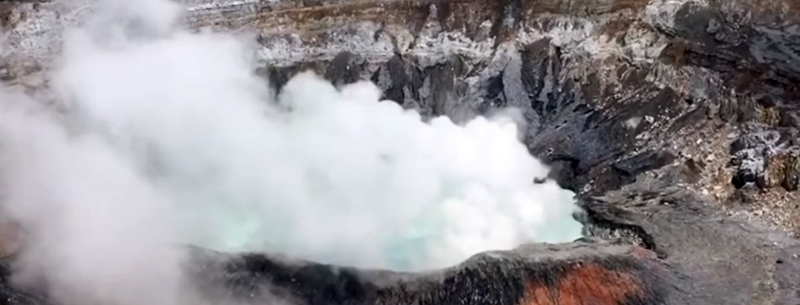Poas Volcano National Park is a well-known Costa Rica national park, not very far away from San Jose. There are many interesting volcanoes in Central America but most of them are not easy to reach. Poas volcano national park is one of the two volcanoes in Costa Rica (Irazu is the other ) where the road takes you up to the crater and you can view the caldera. The Poas Volcano is still active and has a huge crater (1,3 kilometers diameter and 300 meters deep ) with a hot sulfur lake with fumaroles. It is an extraordinary natural wonder: the crater with all its colors and lush vegetation.
https://www.youtube.com/watch?v=RhxIM1jZMrk
The trip takes you along a country road with beautiful small houses with exotic gardens and through many attractive coffee plantations. Near the volcano, you can see the characteristic vegetation of a cloud forest with its bromeliads, epiphytes, and ferns. The road gives you wonderful views over the Central Valley and the Central Mountain Range. You will have time to hike up to the beautiful Botos Lagoon and spend some time at the excellent information center.
Historical Background
The Poas Volcano’s eruptions are known to have occurred as early as of 1747 when the Spanish governor Juan Gemir wrote about its activity. Other activity dates include 1834 when Andrés Oersted recorded underground explosions, and ash thrown from the volcano spread for up to 30 miles. One in 1910 is considered to be the largest eruption of mud, gases, pumice, and ash to be documented. From 1952/54, the last major period of activity with large clouds of ash and glowing rock accompanied by underground rumbling formed the volcano’s present structure. In 1994 there was a smaller eruption that added some rocks to the ‘beach’ around the crater and significantly increased the production of sulfurous gas.
Flora and fauna
The Life Zones represented in the Poas volcano national park are the Mountain Rain Forest and Very Humid Low Mountain Forest. There are four principal habitats. The Cloud Forest surrounds Botos Lake and the back part of the Potrero Grander; here the predominant species are wild papaya, pitch apple, oak, etc. Along the edges of the Caribbean side, the forest is taller and very wet, with numerous palms, tree ferns, and epiphytes. Elfin Forest is found along the Main Crater-Botos Lake trail; the main species are pitch apple, ardisia compressa, and Alzatea verticillata. The arrayanes are predominant near the point overlooking the crater and on the first stretch of the natural Botos Lake trail; in a few areas near the crater there is little vegetation except for a few tolerant colonists like bracken ferns. Although larger animals are scarce, the avifauna is diverse and abundant. A total of 79 species of birds have been identified, including various hummingbirds, Black Guan, Resplendent Quetzal, Rufous-collared Sparrow, Sooty Thrush, Emerald Toucanet, Large-footed Finch, and Yellow-thighed Finch. Few mammals are likely to be seen, though weasels, rabbits, squirrels, and coyotes are present, along with frogs, toads, salamanders, snakes, and insects.
Geology and climate
Poas volcano is with a semi-conical shape, with multiple calderas at its summit. At the bottom of the crater there is a lake that is full of sulfur and acids; as it gets dry sulfur emissions increase producing acid rain. North of the active crater, the Von Frantzius cone is the oldest eruptive center at the top of the massif. On the southeast side, lies another collapsed cone, filled by rainwater to form the Botos Lake. At the Poas volcano national park, the rainy season is from May through November with minimal precipitation the rest of the year. Fog and mist are typical of the site, particularly in the afternoon. The average temperature is 12 degrees and rainfall is 3,500 mm.
Interest facts
- Maximum height: 2,708 meters Main Crater
- Diameter 1,320 meters
- Depth: 300 meters; Botos Lake
- Diameter 400 meters
- Temperature 10-14 degrees C.
